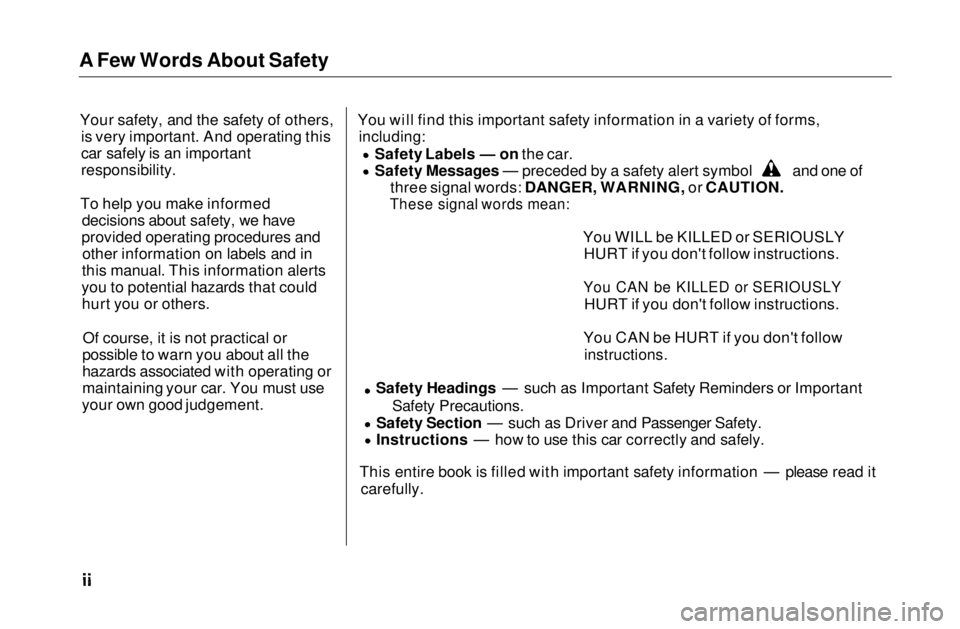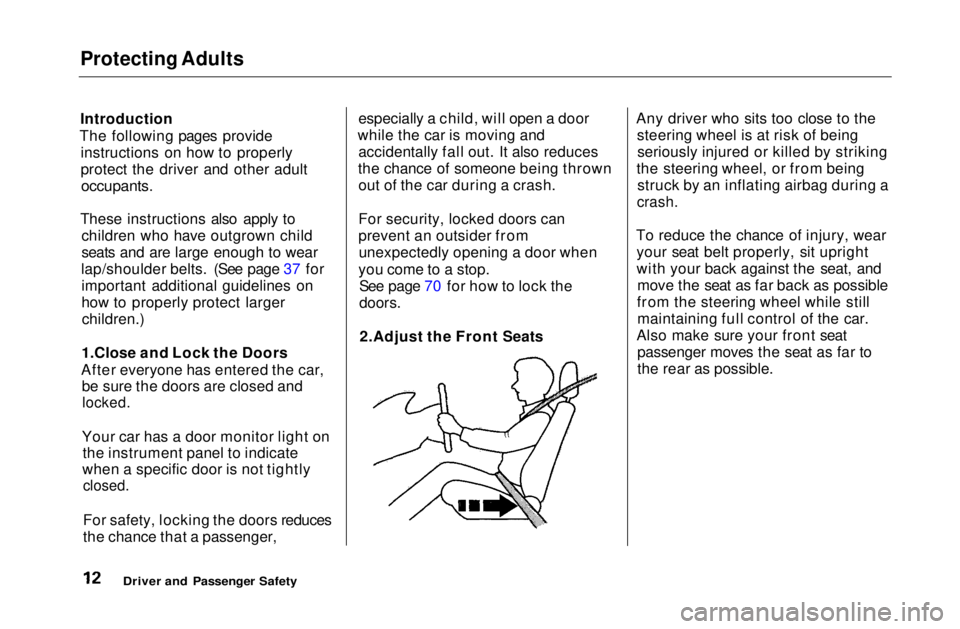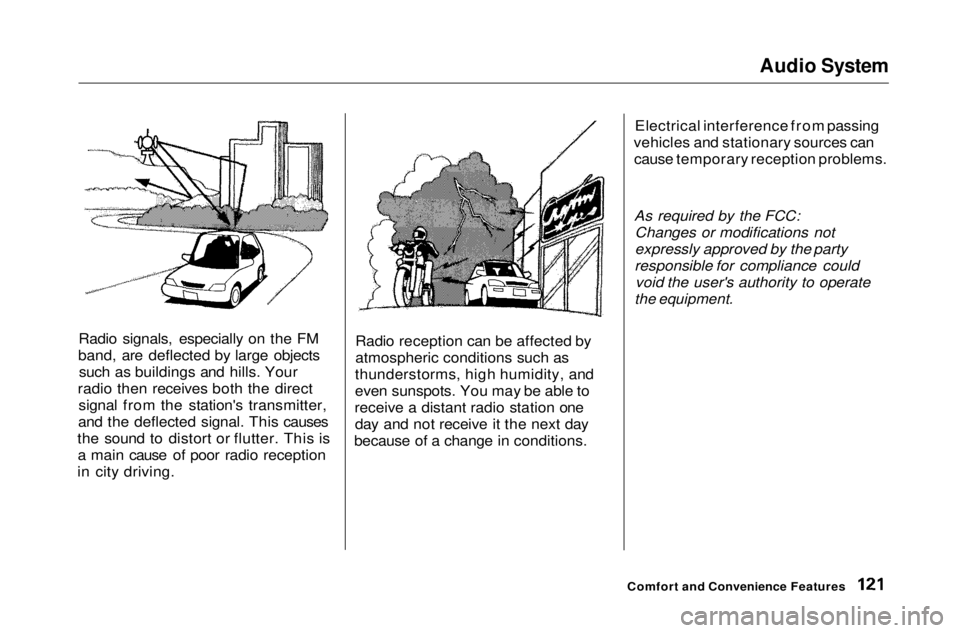1999 HONDA CIVIC COUPE ESP
[x] Cancel search: ESPPage 2 of 269

Introduction
Congratulations ! Your selection of a 1999 Honda Civic was a wise
investment. It will give you years of driving pleasure.
One of the best ways to enhance the enjoyment of your new Honda is to
read this manual. In it, you will learn how to operate its driving controls and
convenience items. Afterwards, keep this owner's manual in your car so you
can refer to it at any time.
Several warranties protect your new Honda. Read the warranty booklet
thoroughly so you understand the coverages and are aware of your rights and responsibilities.
Maintaining your car according to the schedules given in this manual helps
to keep your driving trouble-free while it preserves your investment. When
your car needs maintenance, keep in mind that your Honda dealer's staff is specially trained in servicing the many systems unique to your Honda. Your
Honda dealer is dedicated to your satisfaction and will be pleased to answer
any questions and concerns. As you read this manual, you will
find information that is preceded by symbol. This
information is intended to help you
avoid damage to your Honda, other
property, or the environment.
a NOTICEMain Menu s t
Page 3 of 269

A Few Words About Safety
Your safety, and the safety of others, is very important. And operating this
car safely is an important
responsibility.
To help you make informed decisions about safety, we have
provided operating procedures and other information on labels and in
this manual. This information alerts
you to potential hazards that could hurt you or others.
Of course, it is not practical or
possible to warn you about all the
hazards associated with operating or
maintaining your car. You must use
your own good judgement. You will find this important safety information in a variety of forms,
including:
Safety Labels — on the car. Safety Messages — preceded by a safety alert symbol and one of
three signal words: DANGER, WARNING, or CAUTION.
These signal words mean:
You WILL be KILLED or SERIOUSLYHURT if you don't follow instructions.
You CAN be KILLED or SERIOUSLY
HURT if you don't follow instructions.
You CAN be HURT if you don't follow
instructions.
Safety Headings — such as Important Safety Reminders or Important Safety Precautions.
Safety Section — such as Driver and Passenger Safety. Instructions — how to use this car correctly and safely.
This entire book is filled with important safety information — please read it carefully.Main Menu s t
Page 7 of 269

Important Safety Precautions
You'll find many safety recommendations throughout thissection, and throughout this manual.
The recommendations on this page are the ones we consider to be the
most important.
Always Wear Your Seat Belt
A seat bel
t is your best protection in
all types of collisions. Airbags supplement seat belts, but airbags
are designed to inflate only in a
moderate to severe frontal collision. So even though your car is equipped
with airbags, make sure you and
your passengers always wear your seat belts, and wear them properly. (See page 15.)
Restrain All Children Children are safest when they are
properly restrained in the back seat, not the front seat. A child who is too
small for a seat belt must be properly
restrained in a child safety seat. (See
page 21.) Be Aware of Airbag Hazards
While airbags save lives, they can cause serious or fatal injuries to
occupants who sit too close to them,
or are not properly restrained.
Infants, young children, and short
adults are at the greatest risk. Be sure to follow all instructions and
warnings in this manual. (See page 7.)
Don't Drink and Drive
Alcohol and driving don't mix. Even one drink can reduce your ability to
respond to changing conditions, and
your reaction time gets worse with every additional drink. So don't drink
and drive, and don't let your friends
drink and drive, either. Control Your Speed
Excessive speed is a major factor in
crash injuries and deaths. Generally,
the higher the speed the greater the
risk, but serious accidents can also
occur at lower speeds. Never drive
faster than is safe for current conditions, regardless of the
maximum speed posted.
Keep Your Car in Safe Condition
Having a tire blowout or a
mechanical failure can be extremely
hazardous. To reduce the possibilityof such problems, check your tire
pressures and condition frequently, and perform all regularly scheduled
maintenance. (See page 162.)
Driver and Passenger SafetyMain Menu Table of Contents s t
Page 13 of 269

Protecting Adults
Introduction
The following pages provide instructions on how to properly
protect the driver and other adult
occupants.
These instructions also apply to children who have outgrown child
seats and are large enough to wear
lap/shoulder belts. (See page 37 for important additional guidelines on
how to properly protect largerchildren.)
1.Close and Lock the Doors
After everyone has entered the car, be sure the doors are closed and
locked.
Your car has a door monitor light on the instrument panel to indicate
when a specific door is not tightly
closed.
For safety, locking the doors reduces
the chance that a passenger, especially a child, will open a door
while the car is moving and accidentally fall out. It also reduces
the chance of someone being thrown out of the car during a crash.
For security, locked doors can
prevent an outsider fromunexpectedly opening a door when
you come to a stop. See page 70 for how to lock the
doors.
2.Adjust the Front Seats Any driver who sits too close to the
steering wheel is at risk of beingseriously injured or killed by striking
the steering wheel, or from being struck by an inflating airbag during a
crash.
To reduce the chance of injury, wear your seat belt properly, sit upright
with your back against the seat, and move the seat as far back as possible
from the steering wheel while still maintaining full control of the car.
Also make sure your front seat passenger moves the seat as far to
the rear as possible.
Driver and Passenger SafetyMain Menu Table of Contents s t
Page 22 of 269

Protecting Children
Children depend on adults to protect
them/However, despite their best
intentions, many parents and other adults may not know how to properly
protect young passengers.
So if you have children, or if you ever
need to drive with a grandchild or
other children in your car, be sure to
read this section. All Children Must Be Restrained
Each year, many children are injuredor killed in vehicle crashes because
they are either unrestrained or not
properly restrained. In fact, vehicle accidents are the number one cause
of death of children ages 12 and
under.
To reduce the number of child deaths and injuries, every state and
Canadian province requires that
infants and children be restrained
whenever they ride in a vehicle.
Any child who is too small to wear a seat belt should be properly
restrained in a child seat. (See page
25.)
A larger child should always be
restrained with a seat belt. (See page
37.)
Driver and Passenger Safety
Children who are unrestrained
or improperly restrained can be
seriously injured or killed in a
crash.
Any child too small for a seat belt should be properly
restrained in a child seat. A
larger child should be properlyrestrained with a seat belt.Main Menu Table of Contents s t
Page 47 of 269

Additional Information About Your SRS
Since both airbags use the samesensors, both airbags normally
inflate at the same time. However, it
is possible for only one airbag to
inflate.
This can occur when the severity of a collision is at the margin, or
threshold, that determines whetheror not the airbags will deploy. In
such cases, the seat belt will provide
sufficient protection, and the
supplemental protection offered by
the airbag would be minimal.
After inflating, the airbagsimmediately deflate, so they won't
interfere with the driver's visibility,
or the ability to steer or operate
other controls.
The total time for inflation and deflation is approximately one-tenth
of a second, so fast that most
occupants are not aware that the
airbags deployed until they see them
lying in their laps. After a crash, you may see what
looks like smoke. This is actuallypowder from the airbag's surface.
Although the powder is not harmful, people with respiratory problems
may experience some temporarydiscomfort. If this occurs, get out of
the car as soon as it is safe to do so.
U.S. Owners
For additional information on how
your airbags work, see the booklet
titled SRS: What You Need to Know About Airbags that came with your
owner's manual.
Canadian Owners
For additional information on how
your airbags work, ask your dealer for a copy of the booklet titled SRS:
What You Need to Know About Airbags.
Driver and Passenger SafetyMain Menu Table of Contents s t
Page 75 of 269

Keys
and Locks
Transmitter Care
Avoid severe shock to the trans- mitter, such as dropping or throwing
it. Also, protect it from extreme hot
or cold temperatures.
Clean the transmitter case with a
soft cloth. Do not use strong
cleaners or solvents that could harm
the case. Immersing the transmitter in any liquid will harm the trans-
mitter and cause it to not function
properly.
Use the ring on the transmitter to
attach it to your main key ring. You
could damage the transmitter if you
try to use its ring as a key ring. If you lose a transmitter, you will
need to have the replacement
programmed to your car's system by
your Honda dealer. Any other transmitters you have will also need
to be reprogrammed.
As required by the FCC: This device complies with Part 15 of the
FCC rules. Operation is subject to the
following two conditions: (1) This device
may not cause harmful interference, and (2) this device must accept any
interference received, including
interference that may cause undesired
operation.
This device complies with DOC
standards in Canada.
Changes or modifications not expressly
approved by the party responsible for compliance could void the user's
authority to operate the equipment.
Instruments and ControlsMain Menu Table of Contents s t
Page 122 of 269

Audio System
Radio signals, especially on the FM
band, are deflected by large objects such as buildings and hills. Your
radio then receives both the direct signal from the station's transmitter,
and the deflected signal. This causes
the sound to distort or flutter. This is a main cause of poor radio reception
in city driving. Radio reception can be affected by
atmospheric conditions such as
thunderstorms, high humidity, and
even sunspots. You may be able to
receive a distant radio station one day and not receive it the next day
because of a change in conditions. Electrical interference from passing
vehicles and stationary sources can cause temporary reception problems.
As required by the FCC: Changes or modifications not
expressly approved by the party
responsible for compliance could void the user's authority to operate
the equipment.
Comfort and Convenience FeaturesMain Menu Table of Contents s t